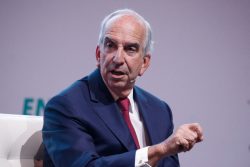SINGAPORE, (Reuters) – Pushed by industry groups to cut emissions by the minimum and pulled by developing nations to cut deeply, Japan’s prime minister went down the middle, and in doing so has undermined global climate talks.
Taro Aso’s decision yesterday to cut Japan’s emissions of planet-warming greenhouse gases by 15 percent below 2005 levels by 2020 showed lack of leadership from a country seen as a crucial player in the fight against climate change, analysts say.
The target is barely tougher than Japan’s current commitment under the Kyoto Protocol and is far less than the 25-40 percent reduction below 1990 levels for rich nations urged by the U.N. Climate Panel.
“I do not believe it is a number that is close to what Japan needs to do, should do,” China’s climate ambassador Yu Qingtai told Reuters on the sidelines of U.N.-led, June 1-12 climate climate talks in Bonn, Germany.
“(Tokyo should) look seriously at what Japan needs to do to make a fair contribution to international cooperation to fight climate change.”
Aso described the target as extremely ambitious but Kim Carstensen, head of WWF’s Global Climate Initiative, called it appalling.
“When signing the Kyoto Protocol, Japan already committed to a 6 percent cut from 1990 levels, to be achieved from 2008 to 2012. The new Aso target would mean that Japan effectively gives dirty industries the freedom to pollute without limits for eight years,” Carstensen said.
The new target is equivalent to a cut of 8 percent below Japan’s 1990 emission levels, and roughly comparable with the U.S. target that is under discussion, the lower end of the EU target range and the middle of Australia’s range.
Analysts say rich nations such as Japan, the world’s fifth-biggest emitter, need to do more to entice developing nations to take steps to curb their rapidly growing carbon pollution.
Failure to do so could mean a weak or no agreement at the end of the year to brake the pace climate change and offset its impact, such as more intense storms, rising seas and melting glaciers.
“These targets are not strong enough to get the world down the road to avoiding dangerous climate change, and could fall short of enticing developing countries into the game,” said Frank Jotzo, climate change economist at the Australian National University in Canberra.
Negotiators are racing to seal a broader climate pact to replace the Kyoto Protocol in December during a U.N. conference in Copenhagen.
“Why should poor countries agree to act while the rich are still refusing to take responsibility?” said Australian Greens Deputy Leader Senator Christine Milne.
“Our so-called world leaders need to realise that this year’s Copenhagen Conference will not be a success unless it delivers an agreement to truly protect the climate. Anything less will be an agreement to fail,” she said.
China and India, the world’s top and fourth-largest emitters respectively, demand rich nations sign up to 2020 cuts of 40 percent below 1990 levels and pledge up to 1 percent of their economic worth to help poorer nations fight climate change.
Developing nations, which now emit more than half of mankind’s greenhouse gas pollution, will not be expected to sign up to legally binding emissions cuts in a new climate agreement from 2013.
“What Japan proposes is going to have a major impact, because it is one of the major developed countries. And China wants to see it set more ambitious goals than Kyoto if China is going to do more,” said Zhang Haibin, an expert on environmental diplomacy at Peking University in Beijing.
To be fair, Aso faced a tough choice, fearful of driving up costs for voters ahead of an election and hurting business during the country’s worst recession in more than half a century.
Japan’s biggest business lobby, Nippon Keidanren, supported a minus 4 percent target on 2005 levels, saying it is the most reasonable in terms of cost.








